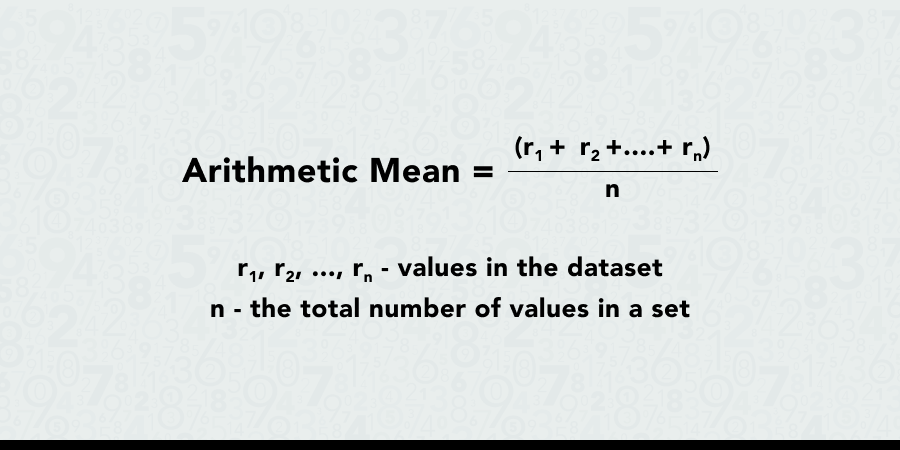SAT® vs. ACT® – Everything You Need to Know in One Easy-to-Follow Guide
Not sure which test to take? Compare SAT® and ACT® test sections, durations, and scoring, and find tips on how to choose the best option for you.

Whether you're learning about the mean for the first time, preparing for an exam, or simply looking to get ahead in your math class, this guide is for you.
Read on to find simple definitions, step-by-step instructions, real-life examples, and exercises to help you master the mean in math.
In math, the mean is the average of a set of two or more numbers. You will often hear it used synonymously with the average.
When we talk about the mean, we’re usually referring to the arithmetic mean—that’s the one you’ll cover in middle school statistics and meet most often in your math class.
The main principle of the arithmetic mean is simple: we add up all the values in a dataset and then divide by how many numbers there are.
For example, to find the arithmetic mean of two numbers, 5 and 9, all we have to do is add them and divide the sum by two.
5 + 9 = 14
14 ÷ 2 = 7
The mean of 5 and 9 is 7.
But that's not all there is to means in math!
As you continue your math journey, you’ll also explore other, more complex types, such as the geometric mean and the harmonic mean.
For now, we will focus on the arithmetic mean and build a solid foundation for future learning.
Find Top-Rated Statistics Tutors Near You
Students typically learn about the mean in middle school, as they begin to explore statistics and understand datasets. Related concepts include:
You may be using the concept of mean more often than you might realize!
Ratings for your favorite games or movies are often based on the mean. These are calculated by adding up all the ratings and dividing them by the number of reviews to get the mean or, as we call it, the average rating.
If you’re on a sports team, whether it’s baseball, basketball, or football, you can use the mean to calculate your average points, goals, or assists per game to see how you’re doing throughout the season.
When you have a set amount of money for a school trip, you can figure out your daily spending by dividing your total spending by the number of days of the trip.
You can even use the mean to calculate average rainfall. If you add up how much rain fell each day over a month and divide it by the number of days, you can find the mean or the average amount of rainfall.
To find the arithmetic mean, we follow these steps:

Not difficult at all, right?
Let’s give it a try!
Suppose you want to track how many pages you read over three days: 20 pages on the first day, 30 pages on the second day, and 10 pages on the third day. To find the average:
So, you read an average of 20 pages per day.
Let's look at some solved examples of the mean in action.
You spent 75 minutes doing homework on Monday, 120 minutes on Tuesday, 57 minutes on Wednesday, 106 minutes on Thursday, and 88 minutes on Friday.
What’s the mean, or average, amount of time you spent doing homework per day this week?
To find the mean, we need to:
1) Add up the total time spent on homework:
75 + 120 + 57 + 106 + 88 = 446
2) Count the number of days:
There are 5 days in this example: Monday, Tuesday, Wednesday, Thursday, and Friday.
3) Divide the total time by the number of days:
Mean = 446/5 = 89.2 minutes.
So, the mean of the time spent on homework each day this week is 89.2 minutes.
You've been busy moving the lawns for pocket money this summer. You worked hard from May to September and inspired your friends to do the same next year.
When they ask you how much you have earned per month on average, all you have to do is calculate the mean.
Here's what you made each month: $320, $280, $350, $400, $330.
To find the mean, you need to:
1) Add up all the amounts spent:
$320 + $280 + $350 + $400 + $330 = $1,680
2) Count the number of months:
As you’ve worked from May to September, earning 5 monthly salaries, divide your earnings by 5 months.
1,680 ÷ 5 = 336
The PE teacher measured the weight of each boy in the class as part of a fitness assessment. He weighed 15 boys and the scales showed:
Let’s calculate the mean weight of the boys in the class.
1) Add up all the weights:
90 + 95 + 100 + 85 + 105 + 98 + 92 + 110 + 88 + 102 + 100 + 96 + 89 + 101 + 97 = 1,448 pounds
2) Count the number of boys:
There are 15 boys in this class.
3) Divide the Total Weight by the Number of Boys:
Mean Weight = 1448/15 ≈ 96.53 lbs
So, the mean weight of the boys in the class is approximately 96.53 pounds.
Time to put your skills to the test! Here are a few examples for you to try on your own.
Once you solve each, scroll to the bottom of the guide to check your answers.
Coach Roberts wants to find out how many goals his soccer team scored on average in their away games. The team played 13 away games, and the goals scored in each game were:
Find the mean number of goals scored per away game.
Your school held a bake sale, and you want to find out how much money you made on average each day over the five days of the sale.
The amounts you earned each day were: $45, $60, $55, $50, and $65.
What’s the mean amount of money made each day?
You’ve been keeping track of the temperatures outside over the past week.
The temperatures were: 72°F, 68°F, 75°F, 70°F, 73°F, 65°F, and 74°F.
What’s the mean temperature for the week?
Here’s a list of common questions students have while learning about the mean:
Students typically first learn about the mean, or average, while covering the basics of statistics in 6th grade.
As they advance, they’ll also explore other types of means, such as the geometric mean and the harmonic mean, often in high school classes.
Yes, you can find the mean with negative numbers! Just add all the numbers, including negatives, together, then divide by the total count.
For example, to find the mean of -3, 2, and -5, first add them up to get -6, and then divide by 3 to get a mean of -2.
The mean, or average, shows up in different math topics:
Mathnasium’s specially trained middle school tutors work with students of all skill levels to help them master any math subject and topic including the mean.
Discover our approach to middle school tutoring:
At Mathnasium, we assess each student’s current skills and consider their unique academic goals to create personalized learning plans that will put them on the best path towards math mastery.
Whether your student is looking to catch up, keep up, or get ahead in your math class, find a Mathnasium Learning Center near you, schedule an assessment, and enroll them today!
If you have completed the 3 examples in the exercise, check your answers here:
How did you do?


Mathnasium meets your child where they are and helps them with the customized program they need, for any level of mathematics.
